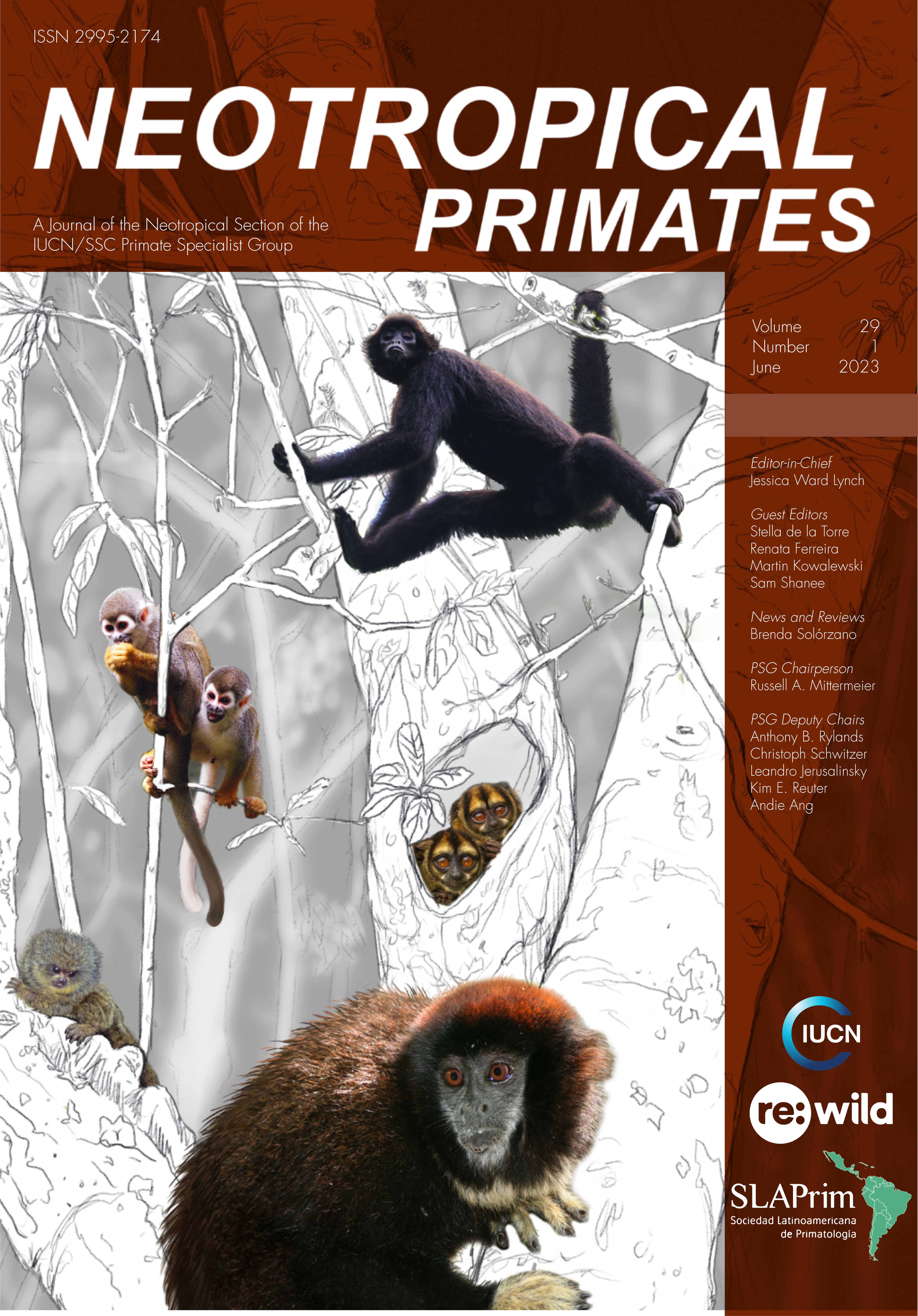Infecção por protozoários em primatas em perigo de extinção (Ateles marginatus) na Amazônia matogrossense
DOI:
https://doi.org/10.62015/np.2023.v29.780Abstract
No abstract
References
Cable, J., Barber, I., Boag, B., Ellison, A. R., Morgan, E. R., Murray, K., Pascoe, E. L., Sait, S. M., Wilson, A. J. e Booth, M. 2017. Global change, parasite transmission and disease control: lessons from ecology. Philos. Trans. R. Soc. Lond., B. Biol. Sci. 372. Website: https://doi.org/10.1098/rstb.2016.0088.
Cunningham, A. A., Daszak, P. e Wood, N. 2017. One Health, emerging infectious diseases and wildlife: two decades of progress? Philos. Trans. R. Soc. Lond., B, Biol. Sci. 372. Website: https://doi.org/10.1098/rstb.2016.0167.
David, E. B., Patti, M., Coradi, S. T., Oliveira-Sequeira, T. C. G., Ribolla, P. E. M. e Guimarães, S. 2014. Molecular typing of Giardia duodenalis isolates from nonhuman primates housed in a Brazilian zoo. Rev. Inst. Med. Trop. Sao Paulo 56: 49–54. Website: https://doi.org/10.1590/S0036-46652014000100007.
Estrada, A., Garber, P. A., Rylands, A. B. et al. 2017. Impending extinction crisis of the world’s primates: Why primates matter. Sci. Adv. 3: e1600946. Website: https://www.science.org/doi/abs/10.1126/sciadv.1600946.
Figueiredo, M. A. P., Manrique, W. G., Nogueira, R. M. S. e Chaves, D. P. 2020. Diversidade de parasitos gastrintestinais em primatas neotropicais de criadouro conservacionista situado na Amazônia maranhense, estado do Maranhão, Brasil. Ars Vet. 36: 12–19. Website: https://doi.org/10.15361/2175-0106.2020v36n1p12-19.
Goldberg, T. L., Gillespie, T.R., Rwego, I. B., Estoff, E. L. e Chapman, C. A. 2008. Forest fragmentation as cause of bacterial transmission among nonhuman primates, humans, and livestock, Uganda. Emerg. Infect. Dis. 14: 1375-82. Website: https://doi.org/10.3201/eid1409.071196.
Haddad, N. M., Brudvig, L. A., Clobert, J., Davies, K. F., Gonzalez, A., Holt, R. D., Lovejoy, T. E., Sexton, J. O., Austin, M. P., Collins, C. D., Cook, W. M., Damschen, E. I., Ewers, R. M., Foster, B. L., Jenkins, C. N., King, A. J., Laurance, W. F., Levey, D. J., Margules, C. R., Melbourne, B. A. e Townshend, J. R. 2015. Habitat fragmentation and its lasting impact on Earth’s ecosystems. Sci. Adv. 1: e1500052. Website: https://doi.org/10.1126/sciadv.1500052.
Kuthyar, S., Kowalewski, M. M., Roellig, D. M., Mallott, E. K., Zeng, Y., Gillespie, T. R. e Amato, K. R. (2020). Effects of anthropogenic habitat disturbance and Giardia duodenalis infection on a sentinel species' gut bacteria. Ecol. Evol. 11: 45–57. Website: https://doi.org/10.1002/ece3.6910.
Levecke, B., Dreesen, L., Dorny, P., Verweij, J. J., Vercammen, F., Casaert, S., Vercruysse, J. e Geldhof, P. 2010. Molecular identification of Entamoeba spp. in captive nonhuman primates. J. Clin. Microbiol. 48: 2988–2990. Website: https://doi.org/10.1128/JCM.00013-10.
Li, J., Wang, Z., Karim, M. R. e Zhang, L. 2020. Detection of human intestinal protozoan parasites in vegetables and fruits: a review. Parasit. Vectors 13: 380. Website: https://doi.org/10.1186/s13071-020-04255-3.
Márquez-Monter, H., Fuentes-Orozco, R., Correa-Lemus, I. e Becker, I. 1991. Invasive amebiasis in a spider monkey (Ateles geoffroyi). Case report and a short review of the literature of amebiasis in non-human primates. Arch. Invest. Med. (Mex.) 22: 75–78.
Monteiro, S. G. 2007. Parasitologia Veterinária (UFSM), Santa Maria.
Pereira, F. V. 2020. Prevalência e distribuição espacial da ocorrência de helmintos em primatas não humanos de vida livre no estado do Rio de Janeiro, Brasil. Arq. Bras. Med. Vet. e Zootec. 72: 1705–1712. Website: https://doi.org/10.1590/1678-4162-11868.
Ravetta, A. e Ferrari, S. 2009. Geographic distribution and population characteristics of the endangered white-fronted spider monkey (Ateles marginatus) on the lower Tapajós River in central Brazilian Amazonia. Primates 50: 261-268. Website: https://doi.org/10.1007/s10329-009-0146-1.
Rondón, S., Cavallero, S., Renzi, E., Link, A., González, C. e D’Amelio, S. 2021. Parasites of Free-Ranging and Captive American Primates: A Systematic Review. Microorganisms 9: 2546. Wesbite: https://doi.org/10.3390/microorganisms9122546.
Rosado-García, F. M., Guerrero-Flórez, M., Karanis, G., Hinojosa, M. D. C. e Karanis, P. 2017. Water-borne protozoa parasites: The Latin American perspective. Int. J. Hyg. Environ. Health 220: 783–798. Website: https://doi.org/10.1016/j.ijheh.2017.03.008.
Ryan, U. e Hijjawi, N. 2015. New developments in Cryptosporidium research. Int. J. Parasitol. 45: 367-373. Website: https://doi.org/10.1016/j.ijpara.2015.01.009.
Silva, R. T. V. 2021. Partição espacial de nicho por três espécies de primatas amazônicos em um fragmento florestal urbano. Dissertação de mestrado, Universidade Federal de Mato Grosso, Mato Grosso, Brasil.
Snak A., Silveira Delgado, L. E. e Osaki, S. C. 2019. Cryptosporidium parvum in captive primates of Parque Municipal Danilo Galafassi, Paraná, Brazil. Semin. Cienc. Agrar. 40: 987–992. Website: https://doi.org/10.5433/1679-0359.2019v40n2p987.
Verweij, J. J., Vermeer, J., Brienen, E. A., Blotkamp, C., Laeijendecker, D., van Lieshout, L. e Polderman, A. M. 2003. Entamoeba histolytica infections in captive primates. Parasitol. Res. 90: 100–103. Website: https://doi.org/10.1007/s00436-002-0808-z.
Downloads
Published
Issue
Section
License

This work is licensed under a Creative Commons Attribution-NonCommercial-ShareAlike 4.0 International License.



